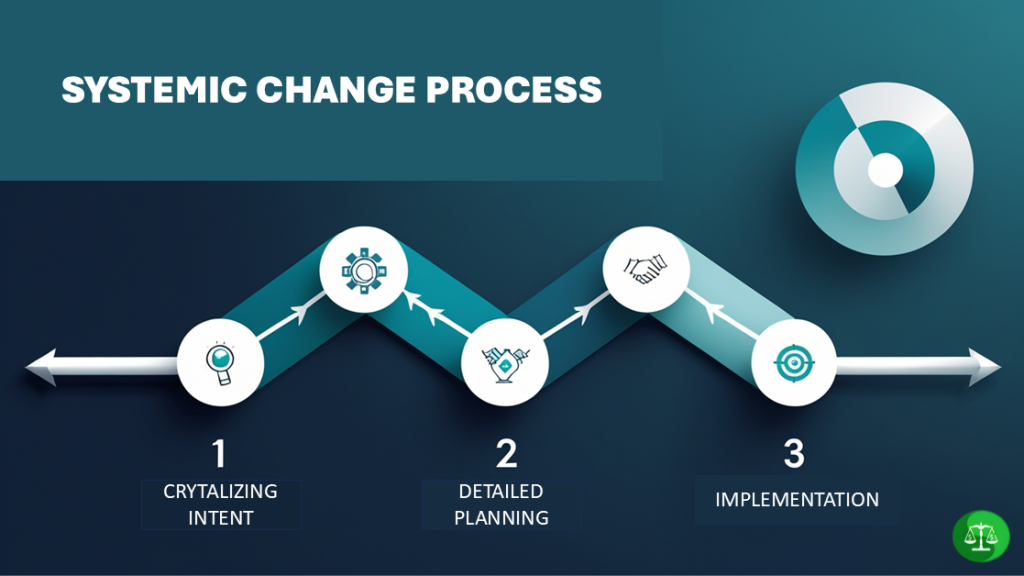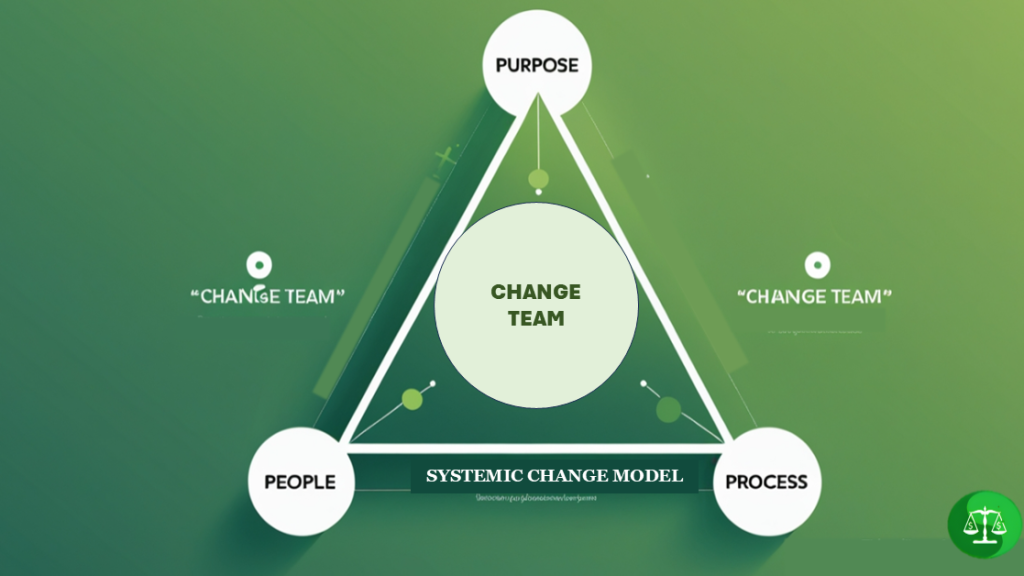SYSTEMIC CHANGE:
A Smarter Approach to Change
Scalable Solutions for Navigating Uncertainty
In an era of constant disruption—whether economic shifts, policy changes, environmental challenges, or social movements—organizations need more than just short-term fixes. The Systemic Change Model offers a strategic, adaptable approach to navigating complexity with confidence. Designed for businesses, government agencies, NGOs, and institutions alike, this framework provides a structured, scalable, and practical tool for strengthening resilience, improving readiness, and driving meaningful transformation. With a holistic methodology that integrates strategy, operations, and culture, the Systemic Change Model equips organizations to stay ahead of change rather than reacting to it.
Why Systemic Change?

Systemic Change stands out for its holistic approach, ensuring that every change initiative, regardless of scale or complexity, addresses challenges at their foundation. Unlike traditional models that may focus on specific elements of change, Systemic Change integrates all essential considerations, providing a comprehensive yet adaptable framework for transformation.
Originally designed to support large-scale sustainability initiatives, the model ensures strategic alignment across multiple levels of execution, from global transformation planning to local implementation. Its unique scalability feature allows organizations to streamline the process by eliminating irrelevant steps, making change management both efficient and cost-effective. The Systemic Change Training Program provides Businesses, NGOs, and Public Institutions alike, with a flexible framework that adapts to any change scenario; and the skills to use it effectively.

Systemic Change Process: A Roadmap for Lasting Transformation
Systemic change is not about quick fixes—it’s about deliberate, structured transformation that drives sustainable results. The process unfolds through three key stages: Crystalize Intent, Develop Detailed Plans, and Implement & Maintain Changes. This framework ensures that organizations move from vision to reality while maintaining alignment, adaptability, and long-term success.
- Crystalize Intent
Establishing Clear Purpose and Commitment
Change efforts often fail due to uncertainty, resistance, and lack of alignment among stakeholders. The first step is to establish absolute clarity about the intent and commitment behind the transformation. This stage focuses on two essential actions:
- Define the Need for Change: Conduct a thorough assessment to understand challenges, risks, and opportunities. Identifying the urgency and expected outcomes of the transformation lays the foundation for success.
- Define Critical Considerations: Time Constraints – Financial Constraints – Quality Requirements – Regulatory & Legal Constraints
- Identify and Confirm Transformation Solutions: Best Practice Study, Innovative Solutions, Modelling.
- Confirm Change Capacity: Establish the organization’s ability to complete the change, and/or the need for external partners.
- Pace of Change: Gradual -Incremental -Radical
- Stakeholder Impact – Environmental Impact – How will the change affect our neighbors and partners?
- Gain Buy-in & Commitment: Ensure all key players—leaders, teams, and stakeholders—are aligned on the vision, purpose, and responsibilities. A well-structured change effort begins with a shared commitment that minimizes resistance and maximizes
2. Develop Detailed Plans: Strategizing for Effective Execution
Once the intent is crystalized, organizations must translate their vision into actionable, structured plans. This stage involves designing a clear roadmap that aligns people, processes, and priorities to achieve the desired transformation.
- Identify Key Change Initiatives: Define specific projects, process improvements, training programs, and policy shifts that will drive change.
- Identify Potential Challenges: An assessment of problems or obstacles the project may encounter, and the appropriate counter measures.
- Develop a Collaborative Plan: Assign roles, establish communication channels, and ensure every level of the organization is engaged in the process.
- Set Success Metrics: Establish measurable benchmarks and feedback loops to track progress and make necessary adjustments along the way.
3. Implement & Maintain Changes: Executing with Precision & Adapting to Realities
The final stage is where transformation becomes tangible. Execution requires strong leadership, coordination, and continuous monitoring to ensure sustained success.
- Execute the Transformation Activities: Roll out the initiatives and strategies developed in the planning phase, ensuring alignment with broader transformation goals.
- Monitor & Adapt: Systemic change is an evolving process. Quality Control and Problem Solving are essential skills in this phase. By continuously evaluating progress, measuring impact, and making necessary refinements, organizations can maintain momentum and overcome unforeseen challenges.
A Framework for Any Industry
This simple yet powerful approach applies across industries, whether for corporate restructuring, cultural shifts, digital transformation, or policy reforms. By focusing on intent, planning, and execution, organizations can drive meaningful change while reducing disruption and maximizing impact.

The Systemic Change Model: Purpose – People – Process
Change within an organization, regardless of its scale or sector, is fundamentally driven by three interconnected areas: Purpose, People, and Process. These elements serve as the foundation of all organizational functions, and any challenge or transformation effort can be traced back to gaps within one or more of these domains.
Unlike rigid change frameworks, this model is designed to be simple yet highly adaptable, making it applicable across industries, organizational structures, and transformation initiatives. Its power lies in its ability to pinpoint the root cause of challenges and drive targeted interventions that minimize disruption to unaffected areas while maximizing impact where change is most needed.
Purpose: Leadership, Strategy, and Governance
This domain encompasses all leadership and decision-making activities, including:
- Goals, Objectives, and Policies – The organization’s direction and guiding principles.
- Core Values – The foundation of ethical and cultural alignment.
- Organizational Structure – How teams and hierarchies are defined.
- Strategic Planning – Long-term vision and competitive positioning.
A misalignment or deficiency in the Purpose domain often leads to unclear goals, ineffective leadership, or structural inefficiencies, which may manifest as operational failures or cultural resistance. Addressing Purpose gaps ensures that strategies align with both internal capabilities and external demands.
People: Human Relations and Interaction
The People domain encompasses all relational and engagement aspects of an organization, including:
- Employee Relations – Workplace culture, engagement, and performance.
- Customer & Stakeholder Relations – Service quality, satisfaction, and partnerships.
- Union & Labor Relations – Workforce negotiations and rights.
- Diversity, Equity & Inclusion (DEI) – Accommodation and fair treatment.
- Conflict Management – Resolving disputes and fostering collaboration.
Challenges in the People domain may stem from poor communication, resistance to change, lack of engagement, or cultural misalignment. Identifying and addressing these gaps ensures that transformation efforts are people-centered, minimizing resistance while fostering cooperation.
Process: Operational Efficiency and Execution
The Process domain governs the efficient and effective use of resources, ensuring that work systems align with strategic and people-related priorities. It includes:
- Process Mapping & Optimization – Streamlining workflows for efficiency.
- Logistics & Resource Management – Effective allocation of assets and materials.
- Productivity & Performance Metrics – Measuring and maximizing output.
- Regulatory Compliance – Adhering to industry standards and legal requirements.
A breakdown in Process often leads to bottlenecks, inefficiencies, or compliance risks. Addressing issues in this domain enhances operational agility, ensuring that strategic plans and workforce capabilities translate into tangible results.
A Targeted Approach to Change
By diagnosing challenges within these three domains, change leaders can develop targeted interventions that prioritize transformation efforts without disrupting well-functioning areas. Additionally, this model helps organizations foresee and plan secondary changes—such as updating work schedules to support new operational procedures—ensuring that transitions are holistic and sustainable.
The Purpose – People – Process Model is both comprehensive enough for large-scale organizational transformation and flexible enough to be customized for specific projects, making it an invaluable tool for sustainable, high-impact change management.
Essential Success Factors for Systemic Change
For any transformation to be successful, Leadership Commitment and Objective-Focused Decisions are paramount. Leaders must not only endorse the vision but must also actively participate in “Crystallizing Intent,” a concept rooted in collective commitment. This means aligning leadership teams around a shared purpose and addressing any conflicting agendas early in the process.
As Peter Senge highlighted, achieving collective commitment is foundational: “A small group of committed citizens can change the world.” Leadership’s role in fostering this commitment extends beyond formal authority; it requires authentic engagement, clear communication, and a genuine investment in the desired outcomes.
Conflicting opinions, needs, and agendas will arise throughout the life of the transformation process. The ability to manage and resolve these conflicts with minimal impact on the goals and objectives of the project is essential to success.
Leveraging Systemic Change for Lasting Impact
Implementing a Systemic Change plan offers a significant advantage in today’s complex world. By framing transformation as a collaborative and comprehensive process, organizations can address challenges holistically. The Systemic Change model is versatile and adaptable, capable of scaling for both small-scale interventions in SMEs and broader initiatives in large organizations or NGOs.
In summary, the Systemic Change model captures the essential elements of traditional change methodologies while offering a framework that’s intuitive and inclusive. The model’s emphasis on leadership, detailed planning, and consistent execution ensures that each transformation initiative meets the organization’s long-term strategic objectives.
Tony Redman
Partner with us on a webinar, or book a private meeting for your group on one of our program topics . Or contact us and we can begin charting the course toward Serenity, Harmony, and Productivity.
“All content © 2024 Mark Anthony Redman / Advoc8 4 Change. Unauthorized reproduction prohibited.”
